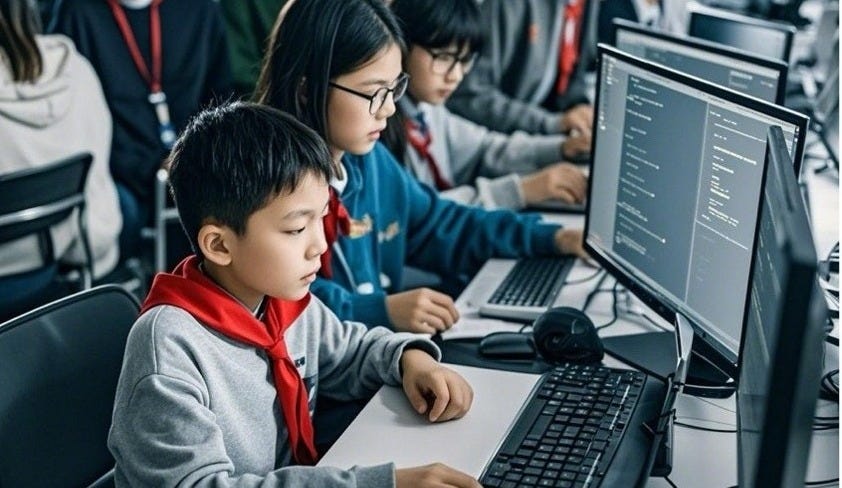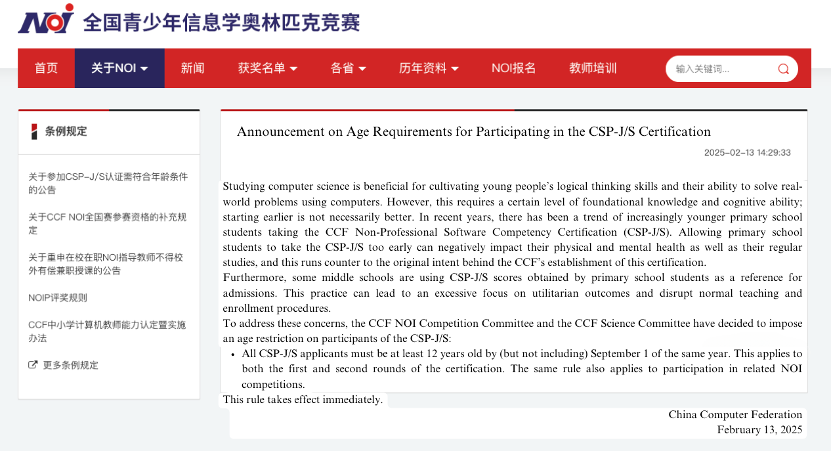Chinese Education Competition: College-Level Coding Contests for the Early-Age Academic Race
How University-Level Exams Became a Battleground for Elementary School Admissions
Chinese Education Competition: College-Level Coding Contests for the Early-Age Academic Race
A programming competition originally intended for college students has unexpectedly turned into a fierce battleground for elementary school admissions. In recent years, Chinese parents have been using "tiger mom" strategies to secure access to high-quality educational resources. Now, the CSP-J/S certification, a computer competency assessment designed for undergraduates, has been repurposed as a stepping stone for early academic advancement. To counter this trend, the Chinese Computer Federation (CCF) urgently announced new rules on February 13, 2025, prohibiting students under the age of 12 from participating. This policy not only highlights the intense competition in Chinese education but also raises broader concerns about the pressure placed on young students.
From College Contests to Early Admissions Warfare
Originally designed to assess programming and algorithmic skills at the university level, the CSP-J/S exam has unexpectedly become a tool in the fiercely competitive elementary-to-middle school admissions process. As traditional academic competitions face tighter regulations, Chinese parents have turned to coding contests to strengthen their children's academic portfolios. The transformation of a higher education assessment into a credential for young students underscores the growing intensity of educational competition.
Chinese Parents' Drive for "Tiger Mom" Education: The High-Stakes Race for Elite Schools
Why do Chinese parents push their children so intensely in academics? The answer lies in a system where competition for elite educational resources is relentless, starting from early childhood and continuing through university admissions. Several factors fuel this drive:
Limited Access to Top Schools:
Elite schools are highly selective. In Beijing’s Haidian District, top-tier middle schools admit fewer than 5% of applicants, while most ordinary schools have a college matriculation rate below 30%.
Housing in top school districts—such as Beijing’s Zhongguancun and Shanghai’s Xuhui—can cost up to 200,000 RMB per square meter, forcing parents to make substantial financial sacrifices for better educational opportunities.
A Brutal Job Market:
With over 12 million college graduates in 2024, competition for prestigious jobs is fierce. Employers favor graduates from elite “985/211” universities, making early academic success crucial for long-term career prospects.
Navigating Policy Changes:
The "Double Reduction" policy, which limits subject-based tutoring, has shifted competition toward alternative extracurriculars like coding and innovation contests. However, unpredictable policy changes—such as the recent CCF age restriction—heighten parental anxiety, prompting them to seek new ways to secure their children's academic future.
With nearly half of middle school students being funneled into vocational tracks, parents perceive early academic competition as essential to avoiding "downward mobility."
The One-Child Investment Strategy:
With most families having only one child, parents channel all resources and expectations into securing the best possible educational trajectory. As one Shanghai parent put it, "We cannot afford to lose. Our child’s failure would be the failure of the entire family."
In this high-stakes environment, parents resort to rigorous academic training and intensive extracurricular activities to safeguard their children's future opportunities.
The official CCF website published the original text of the Announcement on the Age requirements for participating in CSP-J/S Certification.
The New Regulation: Addressing Academic Overload
In response to the growing trend of younger students participating in advanced coding exams, the CCF announced a new policy on February 13, 2025. Effective September 2025, students must be at least 12 years old to register for the CSP-J/S exam. The official statement explains:
"Studying computer science helps young people develop logical thinking and problem-solving skills, but a certain foundational level and an appropriate age range are required… Effective September 2025, candidates for the CSP-J/S exam must be at least 12 years old for both the first and second rounds. The same age requirement will apply to all related NOI competitions."
This measure aims to preserve the exam’s intended purpose while protecting younger students from excessive academic pressure.
The Bigger Picture: The Toll of Early Academic Competition
The use of a university-level exam for elementary school admissions highlights a broader issue within China’s education system. The intense pursuit of elite education has led parents to spend exorbitant sums on top-tier school district housing and enroll their children in a relentless cycle of extracurricular programs. This environment has created overwhelming pressure for even young students to excel academically, sparking debates about the long-term impact on children’s well-being and the future of education.
Finding Balance: The Future of Educational Reform
While the CCF’s new regulation may reduce the number of young participants in these coding contests, it does not address the root causes of parental anxiety. As competition for elite education persists, families will likely turn to alternative competitions and extracurricular achievements to maintain a competitive edge.
Experts argue that meaningful education reform should focus on diversifying school admission criteria, promoting holistic development, and reducing reliance on standardized academic achievements. Ultimately, education should be about nurturing well-rounded individuals rather than merely serving as a stepping stone to prestigious institutions. As the CCF cautions, "Learning computer science should be a gradual process, not a race to start as early as possible."




